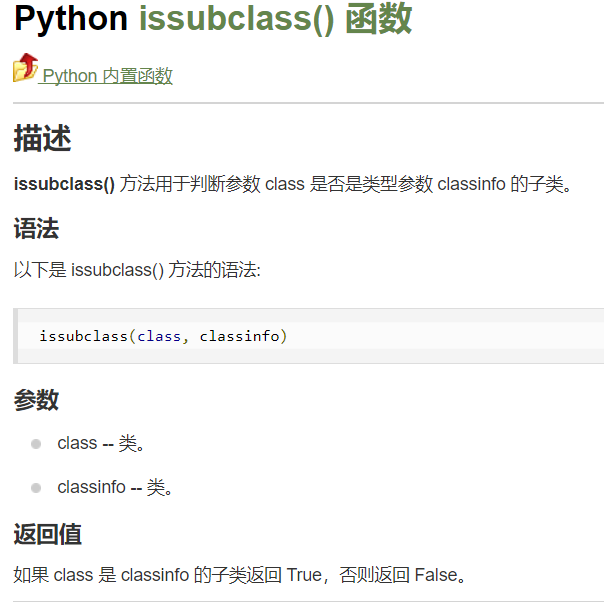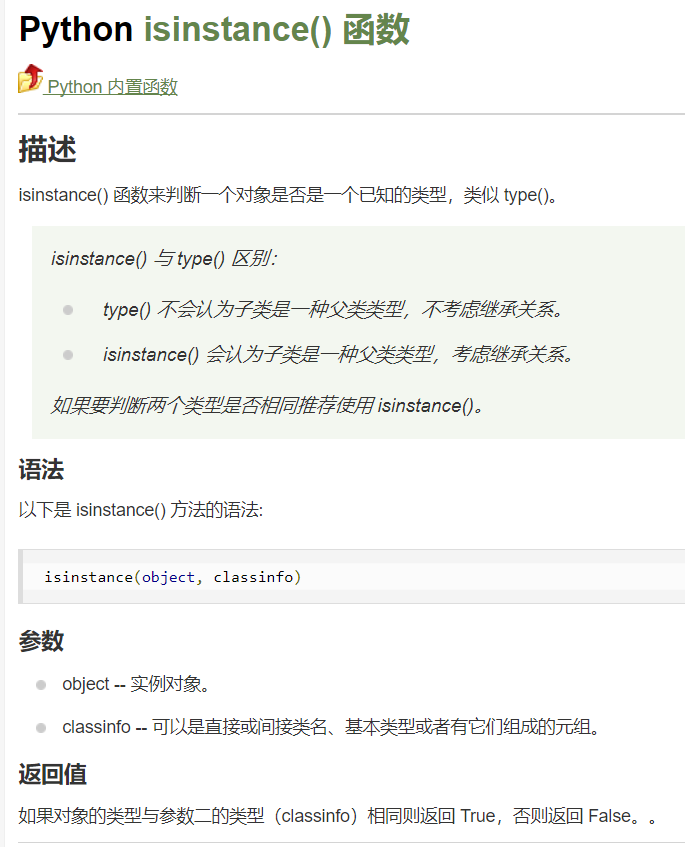

反射
1 什么是反射
反射的概念是由Smith在1982年首次提出的,主要是指程序可以访问、检测和修改它本身状态或行为的一种能力(自省)。这一概念的提出很快引发了计算机科学领域关于应用反射性的研究。它首先被程序语言的设计领域所采用,并在Lisp和面向对象方面取得了成绩。
2 python面向对象中的反射:通过字符串的形式操作对象相关的属性。python中的一切事物都是对象(都可以使用反射)
hasattr
getattr
setattr
delattr
class Foo: f = '类的静态变量' def __init__(self,name,age): self.name=name self.age=age def say_hi(self): print('hi,%s'%self.name) obj=Foo('egon',73) #检测是否含有某属性 print(hasattr(obj,'name')) print(hasattr(obj,'say_hi')) #获取属性 n=getattr(obj,'name') print(n) func=getattr(obj,'say_hi') func() print(getattr(obj,'aaaaaaaa','不存在啊')) #报错 #设置属性 setattr(obj,'sb',True) setattr(obj,'show_name',lambda self:self.name+'sb') print(obj.__dict__) print(obj.show_name(obj)) #删除属性 delattr(obj,'age') delattr(obj,'show_name') delattr(obj,'show_name111')#不存在,则报错 print(obj.__dict__) 四个方法的使用演示
class Foo(object): staticField = "old boy" def __init__(self): self.name = 'wupeiqi' def func(self): return 'func' @staticmethod def bar(): return 'bar' print getattr(Foo, 'staticField') print getattr(Foo, 'func') print getattr(Foo, 'bar')
import sys def s1(): print 's1' def s2(): print 's2' this_module = sys.modules[__name__] hasattr(this_module, 's1') getattr(this_module, 's2')
导入其他模块,利用反射查找该模块是否存在某个方法
#!/usr/bin/env python # -*- coding:utf-8 -*- def test(): print('from the test')
#!/usr/bin/env python # -*- coding:utf-8 -*- """ 程序目录: module_test.py index.py 当前文件: index.py """ import module_test as obj #obj.test() print(hasattr(obj,'test')) getattr(obj,'test')()
__str__和__repr__
改变对象的字符串显示__str__,__repr__
自定制格式化字符串__format__
#_*_coding:utf-8_*_ format_dict={ 'nat':'{obj.name}-{obj.addr}-{obj.type}',#学校名-学校地址-学校类型 'tna':'{obj.type}:{obj.name}:{obj.addr}',#学校类型:学校名:学校地址 'tan':'{obj.type}/{obj.addr}/{obj.name}',#学校类型/学校地址/学校名 } class School: def __init__(self,name,addr,type): self.name=name self.addr=addr self.type=type def __repr__(self): return 'School(%s,%s)' %(self.name,self.addr) def __str__(self): return '(%s,%s)' %(self.name,self.addr) def __format__(self, format_spec): # if format_spec if not format_spec or format_spec not in format_dict: format_spec='nat' fmt=format_dict[format_spec] return fmt.format(obj=self) s1=School('oldboy1','北京','私立') print('from repr: ',repr(s1)) print('from str: ',str(s1)) print(s1) ''' str函数或者print函数--->obj.__str__() repr或者交互式解释器--->obj.__repr__() 如果__str__没有被定义,那么就会使用__repr__来代替输出 注意:这俩方法的返回值必须是字符串,否则抛出异常 ''' print(format(s1,'nat')) print(format(s1,'tna')) print(format(s1,'tan')) print(format(s1,'asfdasdffd'))
class B: def __str__(self): return 'str : class B' def __repr__(self): return 'repr : class B' b=B() print('%s'%b) print('%r'%b)
__del__
析构方法,当对象在内存中被释放时,自动触发执行。
注:此方法一般无须定义,因为Python是一门高级语言,程序员在使用时无需关心内存的分配和释放,因为此工作都是交给Python解释器来执行,所以,析构函数的调用是由解释器在进行垃圾回收时自动触发执行的。

class Foo:
def __del__(self):
print('执行我啦')
f1=Foo()
del f1
print('------->')
#输出结果
执行我啦
------->
class Foo:
def __del__(self):
print('执行我啦')
f1=Foo()
del f1
print('------->')
#输出结果
执行我啦
------->
item系列
__getitem__\__setitem__\__delitem__

class Foo:
def __init__(self,name):
self.name=name
def __getitem__(self, item):
print(self.__dict__[item])
def __setitem__(self, key, value):
self.__dict__[key]=value
def __delitem__(self, key):
print('del obj[key]时,我执行')
self.__dict__.pop(key)
def __delattr__(self, item):
print('del obj.key时,我执行')
self.__dict__.pop(item)
f1=Foo('sb')
f1['age']=18
f1['age1']=19
del f1.age1
del f1['age']
f1['name']='alex'
print(f1.__dict__)
class Foo:
def __init__(self,name):
self.name=name
def __getitem__(self, item):
print(self.__dict__[item])
def __setitem__(self, key, value):
self.__dict__[key]=value
def __delitem__(self, key):
print('del obj[key]时,我执行')
self.__dict__.pop(key)
def __delattr__(self, item):
print('del obj.key时,我执行')
self.__dict__.pop(item)
f1=Foo('sb')
f1['age']=18
f1['age1']=19
del f1.age1
del f1['age']
f1['name']='alex'
print(f1.__dict__)
__new__

class A:
def __init__(self):
self.x = 1
print('in init function')
def __new__(cls, *args, **kwargs):
print('in new function')
return object.__new__(A, *args, **kwargs)
a = A()
print(a.x)
class A:
def __init__(self):
self.x = 1
print('in init function')
def __new__(cls, *args, **kwargs):
print('in new function')
return object.__new__(A, *args, **kwargs)
a = A()
print(a.x)

class Singleton:
def __new__(cls, *args, **kw):
if not hasattr(cls, '_instance'):
cls._instance = object.__new__(cls, *args, **kw)
return cls._instance
one = Singleton()
two = Singleton()
two.a = 3
print(one.a)
# 3
# one和two完全相同,可以用id(), ==, is检测
print(id(one))
# 29097904
print(id(two))
# 29097904
print(one == two)
# True
print(one is two)
单例模式
单例模式
class Singleton:
def __new__(cls, *args, **kw):
if not hasattr(cls, '_instance'):
cls._instance = object.__new__(cls, *args, **kw)
return cls._instance
one = Singleton()
two = Singleton()
two.a = 3
print(one.a)
# 3
# one和two完全相同,可以用id(), ==, is检测
print(id(one))
# 29097904
print(id(two))
# 29097904
print(one == two)
# True
print(one is two)
单例模式
__call__
对象后面加括号,触发执行。
注:构造方法的执行是由创建对象触发的,即:对象 = 类名() ;而对于 __call__ 方法的执行是由对象后加括号触发的,即:对象() 或者 类()()

class Foo:
def __init__(self):
pass
def __call__(self, *args, **kwargs):
print('__call__')
obj = Foo() # 执行 __init__
obj() # 执行 __call__
class Foo:
def __init__(self):
pass
def __call__(self, *args, **kwargs):
print('__call__')
obj = Foo() # 执行 __init__
obj() # 执行 __call__
__len__

class A:
def __init__(self):
self.a = 1
self.b = 2
def __len__(self):
return len(self.__dict__)
a = A()
print(len(a))
class A:
def __init__(self):
self.a = 1
self.b = 2
def __len__(self):
return len(self.__dict__)
a = A()
print(len(a))
__hash__
class A:
def __init__(self):
self.a = 1
self.b = 2
def __hash__(self):
return hash(str(self.a)+str(self.b))
a = A()
print(hash(a))
__eq__
class A:
def __init__(self):
self.a = 1
self.b = 2
def __eq__(self,obj):
if self.a == obj.a and self.b == obj.b:
return True
a = A()
b = A()
print(a == b)

class FranchDeck:
ranks = [str(n) for n in range(2,11)] + list('JQKA')
suits = ['红心','方板','梅花','黑桃']
def __init__(self):
self._cards = [Card(rank,suit) for rank in FranchDeck.ranks
for suit in FranchDeck.suits]
def __len__(self):
return len(self._cards)
def __getitem__(self, item):
return self._cards[item]
deck = FranchDeck()
print(deck[0])
from random import choice
print(choice(deck))
print(choice(deck))
class FranchDeck:
ranks = [str(n) for n in range(2,11)] + list('JQKA')
suits = ['红心','方板','梅花','黑桃']
def __init__(self):
self._cards = [Card(rank,suit) for rank in FranchDeck.ranks
for suit in FranchDeck.suits]
def __len__(self):
return len(self._cards)
def __getitem__(self, item):
return self._cards[item]
deck = FranchDeck()
print(deck[0])
from random import choice
print(choice(deck))
print(choice(deck))

class FranchDeck:
ranks = [str(n) for n in range(2,11)] + list('JQKA')
suits = ['红心','方板','梅花','黑桃']
def __init__(self):
self._cards = [Card(rank,suit) for rank in FranchDeck.ranks
for suit in FranchDeck.suits]
def __len__(self):
return len(self._cards)
def __getitem__(self, item):
return self._cards[item]
def __setitem__(self, key, value):
self._cards[key] = value
deck = FranchDeck()
print(deck[0])
from random import choice
print(choice(deck))
print(choice(deck))
from random import shuffle
shuffle(deck)
print(deck[:5])
class FranchDeck:
ranks = [str(n) for n in range(2,11)] + list('JQKA')
suits = ['红心','方板','梅花','黑桃']
def __init__(self):
self._cards = [Card(rank,suit) for rank in FranchDeck.ranks
for suit in FranchDeck.suits]
def __len__(self):
return len(self._cards)
def __getitem__(self, item):
return self._cards[item]
def __setitem__(self, key, value):
self._cards[key] = value
deck = FranchDeck()
print(deck[0])
from random import choice
print(choice(deck))
print(choice(deck))
from random import shuffle
shuffle(deck)
print(deck[:5])


class Person:
def __init__(self,name,age,sex):
self.name = name
self.age = age
self.sex = sex
def __hash__(self):
return hash(self.name+self.sex)
def __eq__(self, other):
if self.name == other.name and self.sex == other.sex:return True
p_lst = []
for i in range(84):
p_lst.append(Person('egon',i,'male'))
print(p_lst)
print(set(p_lst))
class Person:
def __init__(self,name,age,sex):
self.name = name
self.age = age
self.sex = sex
def __hash__(self):
return hash(self.name+self.sex)
def __eq__(self, other):
if self.name == other.name and self.sex == other.sex:return True
p_lst = []
for i in range(84):
p_lst.append(Person('egon',i,'male'))
print(p_lst)
print(set(p_lst))